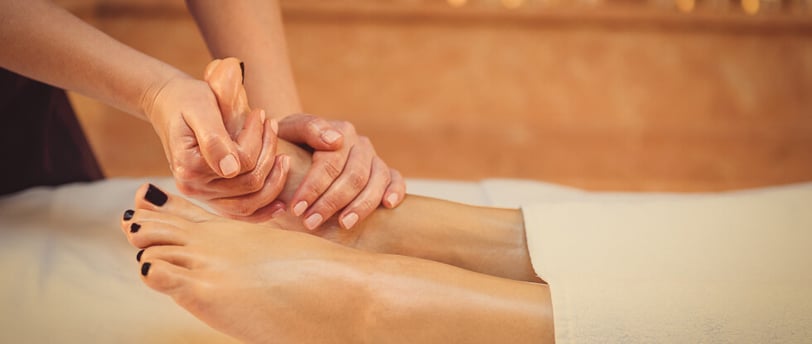The Timeless Benefits of Reflexology: A Path to Wellness
In an age where wellness trends often come and go, some practices stand the test of time, proving their profound efficacy through centuries of anecdotal evidence and growing scientific interest. Reflexology is one such ancient art, a complementary therapy that goes far beyond a simple foot massage.
7/9/20253 min read


In an age where wellness trends often come and go, some practices stand the test of time, proving their profound efficacy through centuries of anecdotal evidence and growing scientific interest. Reflexology is one such ancient art, a complementary therapy that goes far beyond a simple foot massage. It is a precise practice rooted in the belief that specific points on our feet, hands, and ears correspond to every organ, gland, and system in the body. By applying targeted pressure to these "reflex areas," practitioners aim to stimulate the body's innate healing mechanisms, alleviate discomfort, and restore overall balance.
The Ancient Roots and Core Principles of Reflexology
The practice of reflexology boasts ancient roots and core principles that stretch back thousands of years. Evidence suggests its origins in ancient Egypt, China, and even among Native American tribes, with pictographs depicting foot and hand therapy found in Egyptian tombs dating back to 2330 BC.
The fundamental principle revolves around the concept of "zones" or "energy pathways" that run throughout the body, connecting specific reflex points on the extremities to corresponding internal organs and body parts. When these energy pathways become blocked, due to stress, illness, or injury, it can lead to imbalances and discomfort. Reflexologists believe that applying pressure to these reflex points clears these blockages, allowing vital energy to flow freely and promoting the body's natural ability to heal itself and restore homeostasis.
How Reflexology Works: Beyond the Foot Massage
To truly understand its power, it's essential to grasp how reflexology works: beyond the foot massage. While often associated primarily with the feet, reflexology can also be applied to the hands and ears, each offering a complete map of the body's reflexes.
During a session, the practitioner uses specific thumb, finger, and hand techniques to apply pressure to these reflex areas. This pressure is thought to send signals through the nervous system, influencing corresponding organs or systems.
While the exact mechanism is still a subject of scientific research, theories suggest that reflexology may stimulate nerve endings, improve blood circulation, reduce stress hormones, and trigger the release of endorphins—the body's natural painkillers. The systematic application of pressure aims to detect imbalances and encourage a self-healing response, promoting deep relaxation and overall revitalization.
Common Ailments and Conditions Addressed
Reflexology is widely used as a complementary therapy for a range of health concerns, common ailments and conditions addressed by its gentle touch. Its primary benefit is often profound relaxation and stress reduction, which can, in turn, alleviate symptoms of anxiety, tension, and insomnia.
Many individuals seek reflexology for pain management, reporting relief from headaches, migraines, and chronic back pain. It is also explored for its potential to improve circulation, support digestive disorders like irritable bowel syndrome (IBS), and help balance hormonal issues.
While not a cure for serious medical conditions, reflexology is often used to complement conventional medical treatments, aiding recovery, reducing side effects, and improving the overall quality of life for those managing chronic health challenges.
The Benefits: From Relaxation to Revitalization
The spectrum of benefits: from relaxation to revitalization offered by reflexology is broad and impactful. At a fundamental level, it induces a state of deep relaxation, calming the nervous system and reducing the physiological effects of stress.
This relaxation alone can lead to improved sleep quality, enhanced mood, and a greater sense of well-being. Beyond relaxation, many clients report increased energy levels, improved circulation, and detoxification as their bodies become more balanced.
For those with specific discomforts, reflexology can offer targeted relief, lessen pain and improve function in corresponding body parts. It's a non-invasive, safe, and holistic approach that supports the body's innate capacity for self-healing, empowering individuals to take an active role in their health journey.
Finding a Qualified Practitioner and What to Expect
When considering reflexology, finding a qualified practitioner and what to expect is crucial for a beneficial experience. Look for practitioners who are certified by reputable associations or have completed extensive training programs.
A good reflexologist will conduct an initial consultation to understand your health history and specific concerns, tailoring the session to your needs. During a treatment, you will typically lie comfortably on a massage table or recliner.
The therapist will use their thumbs and fingers to apply varying degrees of pressure to your feet, hands, or ears. While some reflex points might feel tender, the overall experience should be relaxing and comfortable. After a session, many people feel a sense of calm, lightness, or increased energy, though some might experience temporary lethargy as the body processes the treatment.
Conclusion
Reflexology Revealed: Unlocking Your Body's Natural Healing Potential underscores the enduring relevance of this ancient healing art in modern wellness. As a gentle yet powerful complementary therapy, reflexology offers a unique pathway to profound relaxation, stress reduction, and the stimulation of the body's intrinsic self-healing capabilities.
By understanding its foundational principles, acknowledging its wide-ranging benefits, and seeking out qualified practitioners, you can embark on a transformative journey towards enhanced well-being. Embrace the wisdom of reflexology and discover how nurturing your extremities can lead to a revitalized and balanced body, mind, and spirit.
Reflexology
Therapeutic practice applying pressure specific points hands ears.
Holistic Therapy
Foot Massage
Foot Reflexology
Reflexology massage
Pain relief therapy
Pressure points
© 2024. All rights reserved. Designed by Pimclick - SEO Agency
